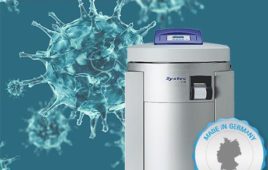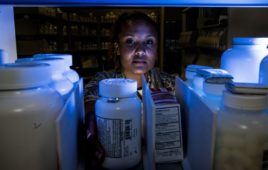Effective cleanroom microbial control requires an understanding of the risk factors associated with microbial contamination, an understanding of effective prevention and remediation steps, and an understanding of the regulatory requirements associated with the use of products and procedures designed to achieve microbial control.
*
Introduction
*Definitions
*Classification of Disinfectants
*Selection of an Antiseptic for Hand and Surgical Site Disinfection
*Selection of a Disinfectant for Use in a Pharmaceutical Manufacturing Environment
*Theoretical Discussion of Disinfectant Activity
*Mechanisms of Disinfectant Activity
*Microbial Resistance to Disinfectants
*Disinfectant Challenge Testing
*Disinfectants in a Cleaning and Sanitization Program
The Introduction makes reference to cGMP requirements relative to facility design and materials selection and how they relate to the overall ability to manufacture drug products properly. USP 1072 includes information on both hard surface and skin sanitization approaches, as both are acknowledged to be important to maintaining microbial control of pharmaceutical manufacturing areas. The document further states, “The cleaning and sanitization program should achieve specified cleanliness standards, control microbial contamination of products, and be designed to prevent the chemical contamination of pharmaceutical ingredients, product-contact surfaces and/or equipment, packaging materials, and ultimately the drug products.” This section clearly states that these issues are relevant not only for aseptic areas and products, but also for non-sterile forms of product dosage.
The Definitions section provides an overview of the commonly used definitions for several microbial control terms and product types. For example, ‘Antiseptic,’ ‘Decontamination,’ ‘Cleaning Agent,’ and ‘Sporicidal Agent’ are all defined in this document. This section also provides a table listing the relative chemical disinfectant resistance of commonly occurring microorganisms, including bacteria, bacterial spores, viruses, and fungi.
The Classification of Disinfectants section provides two tables that give general information on commonly available disinfectants, sporicides, and skin antiseptics. The tables also provide information on performance characteristics such as whether the specific type of chemical is capable of handling soil or is fungicidal. It should be noted that the tables are not exhaustive nor are they specific as to brand names.
The section on Selection of Antiseptics for Hand and Surgical Site Disinfection highlights common antiseptics used in hospital and surgical areas. This section states that, “Use of antiseptics to disinfectant hands has been shown to be more effective than soap and water in reducing counts of bacteria on skin; repeated antiseptic use further reduces these counts. These principles may be applied to cleanroom operators in the pharmaceutical industry.”
The section entitled Selection of a Disinfectant for Use in a Pharmaceutical Manufacturing Environment is followed by two related sections: Theoretical Discussion of Disinfectant Activity and Mechanisms of Disinfectant Activity. The key message from these sections is that there are a number of factors that should be considered when selecting and implementing a disinfectant application program. These factors include:
*The organisms (type and number) to be controlled; the disinfectant activity (including activity against any organic soil which may be present)
*The use concentration, temperature, and contact time variables (all are capable of having a dramatic impact on performance)
*Materials compatibility
*Employee safety
*Compatibility with other chemical cleaning or disinfecting agents used in the area
*The appropriate measures needed to avoid contamination of the product by disinfectant residues
There are several additional factors indicated for consideration in this section that may be a source of debate. These include: “the planned rotation… [of the chemistries]” and “the possible need to maintain a residual bactericidal activity of the disinfectant on the surface…” A later section, Disinfectants in a Cleaning and Sanitization Program, addresses the proper application of “rotation” for total cleanroom control.
The Microbial Resistance to Disinfectants section provides some clarification on the issue of microbial resistance as related to hard surface disinfectants. Although the development of resistance to antibiotic medications by organisms is a fairly well documented and well-understood phenomenon, it is very unlikely that similar resistance actually develops to disinfectants.
Practically speaking, when applying disinfectants to hard surfaces in cleanrooms and other areas, either one is using the proper combination of chemistry, concentration, and contact time to kill the target organisms, or one is not. If not, total kill may not be occurring for a number of reasons related to those application factors, such as selection of the wrong chemistry. An example of this is the use of isopropyl alcohol to address spore-forming organisms. Spores have not “developed a resistance” to alcohol. They were never susceptible to alcohol in the first place. Essentially, poor performance does not imply that organisms have developed a “resistance” to disinfectants.
The Disinfectant Challenge Testing section explains the testing that is required of manufacturers of disinfectants, sterilants (sporicide), or antiseptics to prove efficacy to the EPA for registration purposes. This section also discusses the testing that should be conducted by users of these products in pharmaceutical, biotechnology, and medical device applications to ensure efficacy under their individual use conditions; in other words, in-use validation processes. Two of the key points made in this section are that the current EPA registration requirements do not address the needs of these industries, and that disinfectant application should be treated as a critical processing step that requires validation.
This section also provides guidance to end users on how to structure disinfectant validation studies. Specifically, the document directs that it may be necessary to conduct:
*Use-dilution tests (screening disinfectants for their efficacy at various concentrations and contact times against a wide range of standard test organisms and environmental isolates)
*Surface challenge tests (using standard test microorganisms and microorganisms that are typical environmental isolates, applying disinfectants to surfaces at the selected use concentration with a specified contact time, and determining the log reduction of the challenge microorganisms)
*A statistical comparison of the frequency of isolation and the numbers of microorganisms isolated prior to and after the implementation of a new disinfectant.
Practically speaking, these recommendations are referring to both in vitro suspension studies (use-dilution tests) and in vitro carrier or coupon studies (surface challenge tests), as well as reviews of environmental monitoring data or in situ evaluations of performance.
There are challenges inherent in conducting these types of studies. One challenge is the selection of appropriate chemical neutralizers. USP 1072 gives recommendations for neutralizing agents to use with common disinfectants, but it does not provide guidance on conducting neutralization studies.
Other challenges include the determination of acceptance criteria (i.e. log reductions to demonstrate acceptable performance), the selection of microorganisms to use in testing, and the selection of substrates for coupon studies. USP 1072 provides guidance for log reductions on coupons, but not for suspension studies, as illustrated by this quote: “In practice, sufficient organisms need to be inoculated on a 2-inch x 2-inch square of the surface being decontaminated, i.e., a coupon, to demonstrate at least a 2 (for bacterial spores) to a 3 (for vegetative bacteria) log reduction during a predetermined contact time…”
This section also points out that generally, disinfectants will be more effective in practice, under actual use conditions, than may be represented during laboratory studies. The nature of the inocula and the relatively high inocula levels used for laboratory studies presents a “worst case” scenario, and the stressors present with microorganisms under real-world conditions could affect their numbers.
Selection of microorganisms and substrates for coupon studies are also addressed in this document. Factors that should be used as a guide when considering organisms for testing include: the frequency of its occurrence in the manufacturing environment; the level of decontamination difficulty (i.e., the organism’s level of susceptibility to a disinfectant); and broad spectrum representation (e.g., do they represent gram positive, gram negative, fungal, and spore-forming organisms). Both environmental isolates and clinical strains may be used to accomplish these goals.
Substrate selection should be based on surface area (i.e., materials that constitute large surface areas, such as floors and walls), decontamination difficulty, and surface function/criticality. Examples of typical substrates include 316L stainless steel, Lexan®, epoxy flooring, and various plastics and elastomers.
The final section, Disinfectants in a Cleaning and Sanitization Program, addresses disinfectant application issues such as SOP development and employee training. The emphasis is on training in microbiology and industry standard application and handling practices for disinfectants (including safety and correct use-dilution preparation).
Safety is strongly and appropriately emphasized, particularly in regard to the differences in the handling of disinfectant concentrates and use-dilutions. Disinfectant use dilutions tend to be far less potentially harmful to skin and eyes than the concentrates, which are predominantly corrosive agents.
Additionally, in regard to the earlier discussion of microbial resistance and rotation, this final section emphasizes that “it may be prudent to augment the daily use of a bactericidal disinfectant with weekly (or monthly) use of a sporicidal agent.” This is standard practice for a successful microbial control program and wholly warranted. One must try to seek a balance between the corrosive effects from frequent use of common sporicidal agents and the need to control difficult organisms such as spore forming bacteria and certain molds. The use of both a disinfectant and a sporicidal agent is the only way to balance these two concerns.
Finally, this section once again emphasizes the need to address residual disinfectants in order to avoid product contamination. There is no doubt that some frequency of rinsing, specifically to remove disinfectant residue build-up, is necessary for proper cleanroom maintenance.
As a technical support professional providing expertise on disinfectant selection, application, and validation, I am in a position to view the practices at a number of pharmaceutical, biotechnology, and medical device manufacturing facilities. Many facilities share their SOPS, EM data, 483 observations and Warning Letters with me so that I can assist them in developing more robust and compliant microbial control programs.
USP 1072 is largely a sound document. It is lacking detail in some sections, but one could argue that too many details would raise more issues and would ultimately be a disservice to the industry. There are a wide variety of practices being developed and implemented by manufacturers today that result in successful microbial control programs.
This document provides valuable information to those facilities that have yet to develop disinfectant programs. However, USP 1072 is not a panacea. It should be used in conjunction with successful experience and the available technical literature on all the topics covered here.
Until recently, guidance from regulatory authorities on these issues has been minimal, especially regarding disinfectant validation. Although the FDA has not yet released a guidance document on disinfectant application or validation, numerous ‘483’ observations and warning letters have been issued for various disinfectant application issues, including validation inadequacies. These observations can be viewed as informal guidance.
In addition, USP has developed an informational chapter 1072, Disinfectants and Antiseptics, which may be helpful to those involved in cleanroom microbial control and disinfectant validation. This chapter is currently an In-Process Revision that can be found in USP 29 (3).
The main sections of USP 1072 are as follows:



